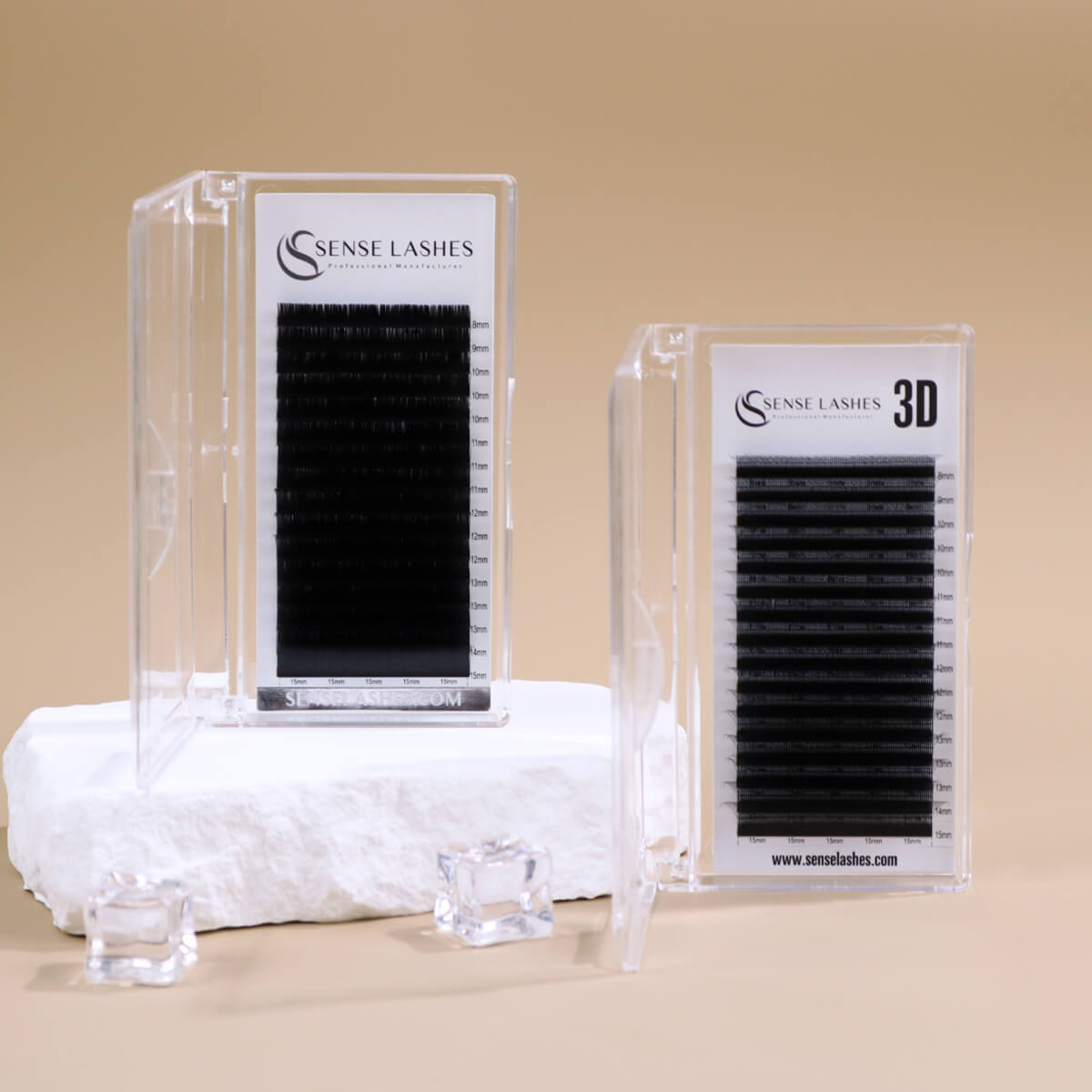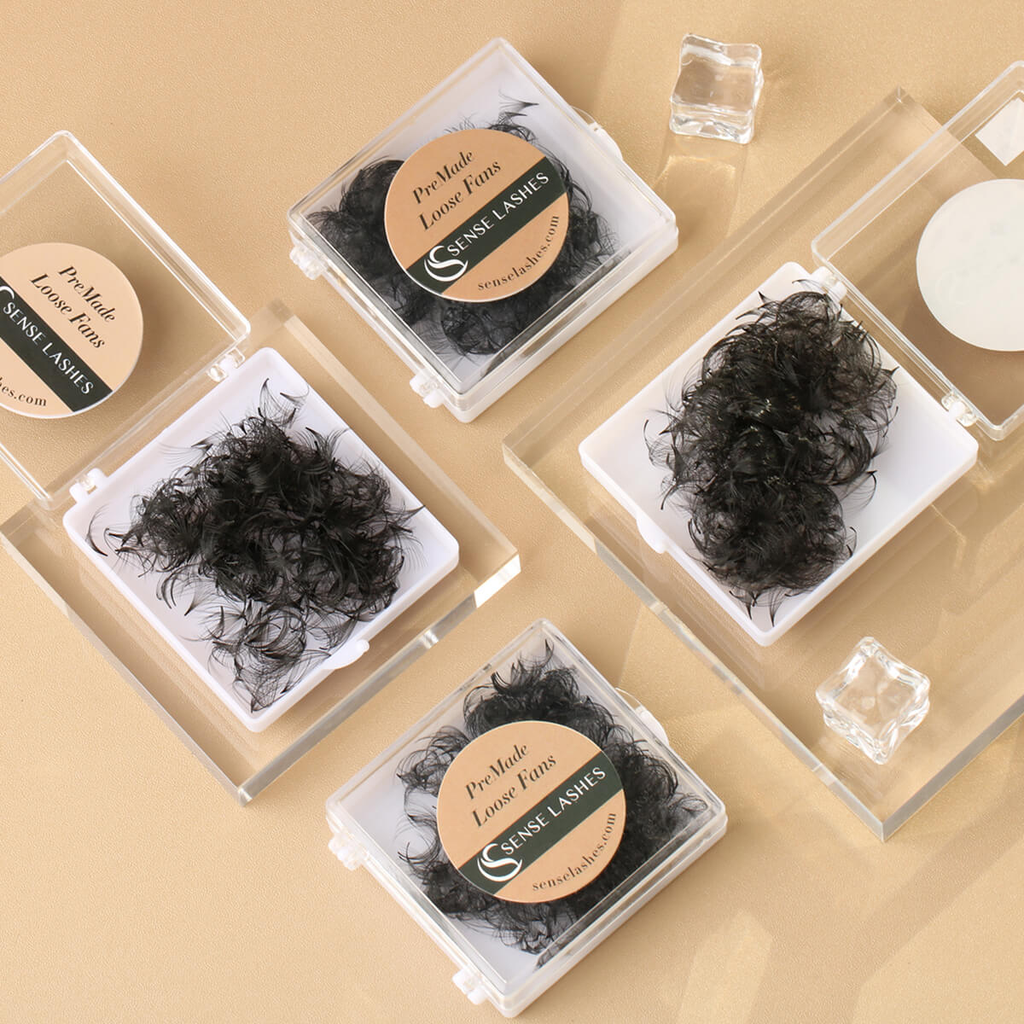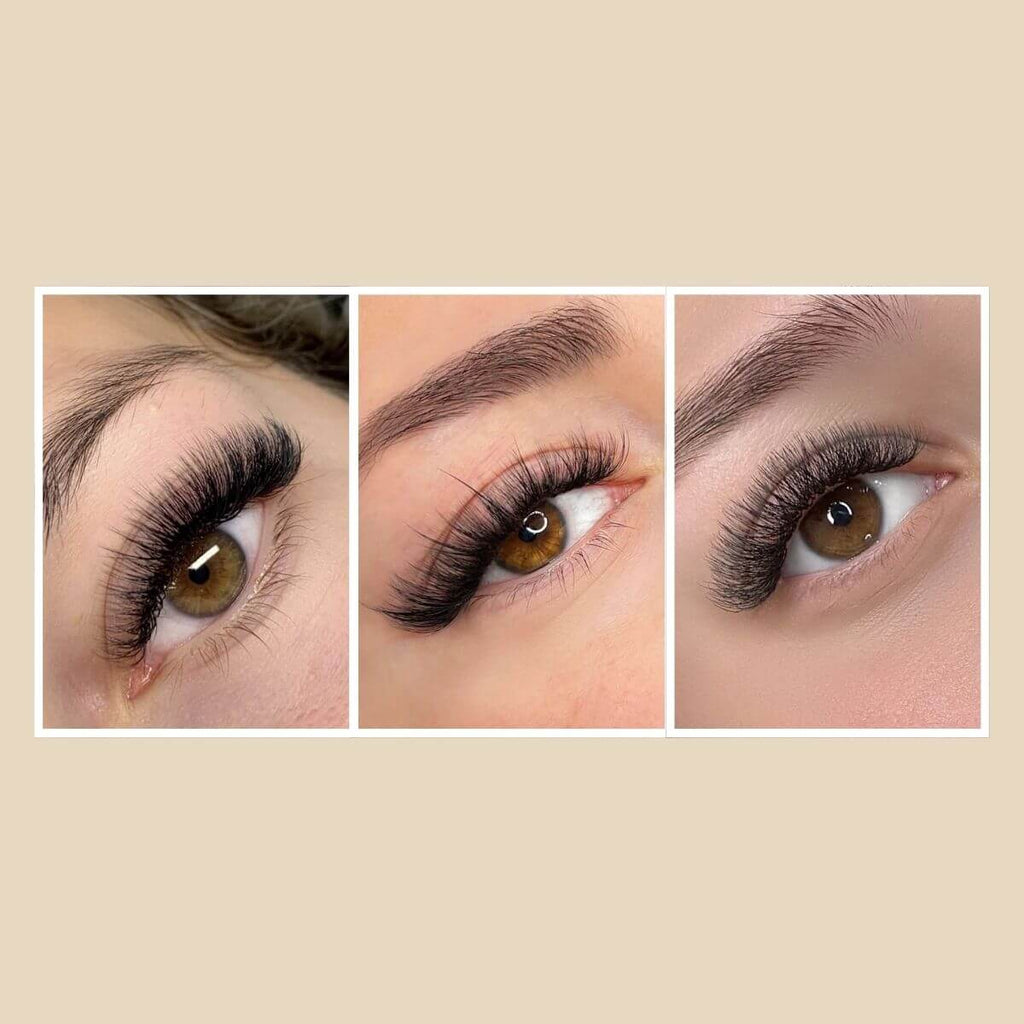Lash Extension Diameter: The Complete Pro Guide to Safe Weights, Fan Sizes, and Retention
If you do lashes, diameter is the quiet decision that makes or breaks a set. In this blog, you’ll get clear, table-ready rules for choosing thickness, pairing it with the right fan sizes, and protecting natural lashes while keeping the look your client wants. By the end, you’ll have a system you can apply at the table on any client.
What Is Lash Extension Diameter?
Lash extension diameter is the thickness of a single extension, usually 0.03–0.20 mm. Smaller numbers are thinner and lighter; larger numbers are thicker and heavier.
Diameter vs Length vs Curl
- Length sets how long the lashes look.
- Curl sets how open and lifted the eye appears.
- Diameter sets weight, density, and ultimately retention.
Why Diameter Controls Weight, Density, and Retention
Weight adds up fast. A thick classic can overload a weak natural lash sooner than a light multi-lash fan. Choosing the right diameter lets you deliver darkness and definition without stressing the natural lash.Get diameter right first, then tune curl and length. That order keeps your design safe, consistent, and easier to maintain.

Lash Diameter Chart: From 0.03 mm to 0.20 mm
Use the chart as a starting point and adjust to the client in front of you. The goal is a look they love at a load their lashes can comfortably carry.
| Diameter | Typical Use | Recommended Fan (D) | Natural Lash Type | Best For | Notes |
| 0.03 | Mega volume | 10–14D+ | Strong, healthy | Dense, dark line | Ultra-light; advanced handling |
| 0.05 | Full volume | 5–10D | Medium–strong | Glam volume | Strong control-to-weight balance |
| 0.07 | Soft volume / hybrid | 3–6D | Most clients | Natural fullness | Versatile; beginner friendly |
| 0.10 | Light volume / classic | 2–3D or 1:1 | Short or weaker | Baby classic, gap fill | Use sparingly in fans |
| 0.12–0.15 | Classic | 1:1 | Average | Defined daily sets | Staple classic sizes |
| 0.18–0.20 | Bold classic | 1:1 | Very strong | High-impact classic | Consider flat fibers to cut load |
Quick Picks by Goal
- Natural, everyday: 0.07 in 3–4D or 0.12–0.15 classic
- Glam but safe: 0.05 in 6–8D or 0.07 in 4–6D
- Mega density: 0.03 in 10–14D on strong lashes
- Eyeliner effect without bulk: tight mapping with 0.05–0.07 fans
Treat this chart as a guide, not a rule book. If lash health and comfort disagree with the plan, dial down diameter and rebuild depth with mapping and fan count.

Safe Weight Rules: Pair Diameter and Fan Size Without Damage
Clients ask for a look; you manage the load. Safe weight choices prevent twisting, breakage, and early shed—no matter the style.
Practical Equivalencies (Training Aids)
Use these to think in “safe load.” They’re approximations; always judge the natural lash.
| Classic vs Volume | Approximate Equivalency | When to Use |
| 1×0.15 | ≈ 3×0.07 | Clean classic vs soft 3D |
| 1×0.18 | ≈ 5×0.07 | Bold classic vs 5D with thin fibers |
| 1×0.20 | ≈ 6–7×0.07 | Dramatic classic vs moderate volume |
| 1×0.15 | ≈ 5×0.05 | Classic line vs dense 5D (0.05) |
Adhesive and Bonding Surface
Large glue beads and shallow attachments add hidden weight and leverage. Aim for thin, even bond lines and full, flush contact on the natural lash.When in doubt, lighten the fiber and keep bases slim. You’ll keep the look—and your client’s natural lashes will thank you for it.

Client Assessment: Choose the Right Diameter in 60 Seconds
A quick, consistent intake keeps you from guessing. Scan the natural lash, ask two or three health questions, and match the style to a safe load.
Natural Lash Audit
- Thickness: fine, average, or thick
- Length: short lashes carry less weight
- Density: sparse areas need lighter fans and careful mapping
Health History and Red Flags
- Early shedding or breakage in the past
- Recent illness/medications/allergies
- Adhesive sensitivity or heavy eye-cream use
Style Goal vs Safe Load (Fast Matrix)
- Weak/short: 0.07–0.10 in 2–3D, or baby classics
- Average: 0.12–0.15 in 1:1 classics, moderate lengths
- Strong/long: 0.18–0.20 classic, or 0.05 in 6–8D
- Mega look: 0.03–0.05 in 10–14D on strong lashes; ease off in corners
If anything feels borderline, choose the lighter path and rebuild intensity with mapping. Safety earns retention—and repeat bookings.

0.03 vs 0.05 vs 0.07: Which Diameter Wins for Volume?
All three can deliver volume. Your pick depends on the client’s lash strength, your handling comfort, and the fan size needed to hit the brief.
0.03 — Mega Density, Lowest Weight Per Fiber
Use for 10–14D+ on strong lashes. It delivers a deep lash line at minimal per-lash load. Handle gently; fibers bend easily.
0.05 — The Glam Sweet Spot
Use for 5–10D on medium to strong lashes. It balances control and darkness without the stiffness of heavy classics.
0.07 — Everyday Volume and Hybrid
Use for 3–6D on most clients. It’s forgiving, versatile, and great for building soft fullness.
Mixing Diameters Without Uneven Weight
Blend 0.05 in corners (lighter load) with 0.07 in the center (depth). Keep mapping symmetric so both eyes carry similar weight.If your hands prefer one diameter, let mapping and fan count finish the job. Technique consistency beats constant swapping.
Classic Sets: 0.12–0.20 mm Done Right
Classic work looks simple, but weight choices still matter. Pick a diameter that defines the line without overloading the lash.
0.12–0.15 — Mascara-Like Daily Classics
Great for average natural lashes. Keep lengths moderate so the set feels light and stays tidy between fills.
0.18–0.20 — Only on Strong Lashes
Reserve for naturally thick lashes. If a client wants bold but can’t carry it, switch to volume with thin fibers or use flats.
Flat vs Round Lashes: Same Impact, Less Weight
Flat (ellipse) fibers hug the natural lash and reduce effective weight at the same diameter. A 0.15 flat can mimic a heavier round look with less stress.
Classics should feel clean and effortless. If a set reads heavy or droopy, step back the diameter one notch and shorten lengths by 1–2 mm.
Retention Fixes: When Shedding Means Your Diameter Is Off
Not all early shed is glue trouble. If the heaviest zones fail first, you’re probably looking at a load problem, not chemistry.
Overload vs Adhesive Problems: How to Tell
- Overload: twisting, leaning bases, droop in dense zones, “heavy” feeling
- Adhesive/environment: even shed across zones, humidity mismatch, frosting
Downgrade Diameter Without Losing Impact
- 0.15 classic → 0.07 in 4–5D with tighter mapping
- 0.18 classic → 0.05 in 6–8D and reduce length 1–2 mm
- Keep center rich; lighten inner and outer thirds
Isolation, Humidity, and Attachment Angle
Clean isolation, within-range humidity, and flush attachment extend wear even when diameter is perfect.Fix the load first, then refine technique. Most “mystery” retention issues improve once weight matches the natural lash.
Mapping That Protects Natural Lashes (But Delivers the Look)
Smart mapping lets you place weight where it’s safe and still hit the style notes your client expects.
Zonal Fan Strategy
- Inner third: shortest lengths, lightest fans (0.05 in 3–4D or 0.07 in 2–3D)
- Center: heaviest fans for depth (0.05 in 6–8D or 0.07 in 4–6D)
- Outer third: step down diameter or fan size to prevent droop
Length Caps for Weak Zones
Cap early if you see thin or short inner corners. Neat and light beats long and heavy every time.
Eyeliner Effect with Light Diameters
Layer short, dense fans at the base with 0.05–0.07, then lift lengths modestly through the midline to “draw” a line without bulk.When mapping carries the look, diameter can stay conservative. That mix creates comfortable sets that still read bold.
7 FAQs About Lash Extension Diameter
Q1. Is 0.07 good for beginners?
Yes. 0.07 is easier to control than 0.03 or 0.05 and still builds soft volume with 3–6D fans. Most clients tolerate it well. Keep corners light, isolate cleanly, and use thin bond lines to avoid stiffness.
Q2. Can I mix 0.05 and 0.07 in one set?
You can, as long as total load stays even. Many artists run 0.05 in outer corners (lighter) and 0.07 in the center (darker). Match fan size to diameter so both eyes carry similar weight and depth.
Q3. What diameter is best for classic lashes?
For most clients, 0.12–0.15. It defines without feeling heavy. Go lighter (0.10–0.12) for short or weak lashes. Save 0.18–0.20 for naturally strong lashes, or use flat fibers to cut weight.
Q4. Is 0.20 too heavy for daily wear?
Often, yes. It can work on strong natural lashes, but it’s not universal. If the client wants bold classics without the load, try 0.15 flat or a volume approach with thin fibers.
Q5. What’s the safest diameter for mega volume?
0.03. It allows high fan counts with minimal per-lash weight. Use on strong lashes, keep bases slim, and lighten the corners to prevent droop.
Q6. Flat vs round: which is lighter at the same diameter?
Flat fibers feel lighter and wrap better because of their shape and contact area. A 0.15 flat will often feel lighter than a 0.15 round while giving a similar line.
Q7. Why do clients shed fast after two weeks?
Common causes: overload from thick fibers, bulky bond lines, poor isolation, or humidity outside your adhesive’s range. Review aftercare too—daily cleansing, less oil near the lash line, and clean pillowcases help retention.Keep these answers consistent across your team. Clear, simple guidance sets expectations and reduces redos.
Glossary for New Artists
Shared vocabulary keeps training tight and consultations quick. Use these definitions in your manuals and client handouts.
- Diameter: Thickness of the extension fiber in millimeters.
- Fan (D): A group of thin fibers attached to one natural lash (e.g., 6D = six fibers).
- Safe Load: Total weight a natural lash can carry without damage.
- Flat vs Round: Flat fibers have an elliptical base that improves wrap and cuts effective weight.
- Attachment Zone: Area on the natural lash where the extension is bonded.
- Bond Line: The adhesive area at the base of the extension or fan.
- Isolation: Separating a single natural lash before attaching an extension.
- Mapping: Planned layout of lengths, curls, and densities across zones.
- Mega Volume: Dense sets using ultra-fine fibers (usually 0.03) with large fans.
Make this glossary part of your intake packet and training deck. Fewer mixed terms means faster, cleaner work.
Bottom Line
Diameter is the quiet decision that makes or breaks a set. Match fiber thickness to natural lash strength first, then shape the look with fan size, mapping, and length. Keep bond lines thin, control weight in the inner and outer thirds, and step down diameter if retention dips. When you treat diameter like a safety rule—not an afterthought—you get cleaner lines, better comfort, and clients who come back because their lashes last.





Leave a comment